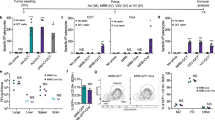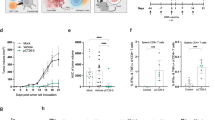Abstract
Effective cancer immunotherapy requires the release of a broad spectrum of tumor antigens in the context of potent immune activation. We show here that a cDNA library of normal tissue, expressed from a highly immunogenic viral platform, cures established tumors of the same histological type from which the cDNA library was derived. Immune escape occurred with suboptimal vaccination, but tumor cells that escaped the immune pressure were readily treated by second-line virus-based immunotherapy. This approach has several major advantages. Use of the cDNA library leads to presentation of a broad repertoire of (undefined) tumor-associated antigens, which reduces emergence of treatment-resistant variants and also permits rational, combined-modality approaches in the clinic. Finally, the viral vectors can be delivered systemically, without the need for tumor targeting, and are amenable to clinical-grade production. Therefore, virus-expressed cDNA libraries represent a novel paradigm for cancer treatment addressing many of the key issues that have undermined the efficacy of immuno- and virotherapy to date.
This is a preview of subscription content, access via your institution
Access options
Subscribe to this journal
Receive 12 print issues and online access
$209.00 per year
only $17.42 per issue
Buy this article
- Purchase on Springer Link
- Instant access to full article PDF
Prices may be subject to local taxes which are calculated during checkout






Similar content being viewed by others
Change history
14 August 2012
In the version of this article initially published, ASEL-CD8 in Figure 3h was incorrectly labeled. The error has been corrected in the HTML and PDF versions of the article.
References
Drake, C.G., Jaffee, E.M. & Pardoll, D.M. Mechanisms of immune evasion by tumors. Adv. Immunol. 90, 51–81 (2006).
Koos, D. et al. Tumor vaccines in 2010: need for integration. Cell. Immunol. 263, 138–147 (2010).
Le, D.T., Pardoll, D.M. & Jaffee, E.M. Cellular vaccine approaches. Cancer J. 16, 304–310 (2010).
Parato, K.A., Lichty, B.D. & Bell, J.C. Diplomatic immunity: turning a foe into an ally. Curr. Opin. Mol. Ther. 11, 13–21 (2009).
Prestwich, R.J. et al. Oncolytic viruses: a novel form of immunotherapy. Expert Rev. Anticancer Ther. 8, 1581–1588 (2008).
Smyth, M.J., Dunn, G.P. & Schreiber, R.D. Cancer immunosurveillance and immunoediting: the roles of immunity in suppressing tumor development and shaping tumor immunogenicity. Adv. Immunol. 90, 1–50 (2006).
Daniels, G.A. et al. A simple method to cure established tumors by inflammatory killing of normal cells. Nat. Biotechnol. 22, 1125–1132 (2004).
Kottke, T. et al. Antitumor immunity can be uncoupled from autoimmunity following heat shock protein 70-mediated inflammatory killing of normal pancreas. Cancer Res. 69, 7767–7774 (2009).
Kottke, T. et al. Induction of hsp70-mediated, TH17 autoimmunity can be exploited as immunotherapy for metastatic prostate cancer. Cancer Res. 67, 11970–11979 (2007).
Sanchez-Perez, L. et al. Killing of normal melanocytes, combined with hsp70 and CD40L expression, cures large established melanomas. J. Immunol. 177, 4168–4177 (2006).
Sanchez-Perez, L. et al. Potent selection of antigen loss variants of B16 melanoma following inflammatory killing of melanocytes in vivo. Cancer Res. 65, 2009–2017 (2005).
Ferrone, S. Immunotherapy dispenses with tumor antigens. Nat. Biotechnol. 22, 1096–1098 (2004).
Turk, M.J., Wolchok, J.D., Guevara-Patino, J.A., Goldberg, S.M. & Houghton, A.N. Multiple pathways to tumor immunity and concomitant autoimmunity. Immunol. Rev. 188, 122–135 (2002).
Braxton, C.L., Puckett, S.H., Mizel, S.B. & Lyles, D.S. Protection against lethal vaccinia virus challenge by using an attenuated matrix protein mutant vesicular stomatitis virus vaccine vector expressing poxvirus antigens. J. Virol. 84, 3552–3561 (2010).
Cobleigh, M.A., Bouonocore, L., Uprichard, S.L., Rose, J.K. & Robek, M.D. A vesicular stomatitis virus-based hepatitis B virus vaccine vector provides protection against challenge in a single dose. J. Virol. 84, 7513–7522 (2010).
Geisbert, T.W. et al. Single-injection vaccine protects nonhuman primates against infection with marburg virus and three species of ebola virus. J. Virol. 83, 7296–7304 (2009).
Schwartz, J.A. et al. Potent vesicular stomatitis virus–based avian influenza vaccines provide long-term sterilizing immunity against heterologous challenge. J. Virol. 84, 4611–4618 (2010).
Bridle, B.W. et al. Vesicular stomatitis virus as a novel cancer vaccine vector to prime antitumor immunity amenable to rapid boosting with adenovirus. Mol. Ther. 17, 1814–1821 (2009).
Bridle, B.W. et al. Potentiating cancer immunotherapy using an oncolytic virus. Mol. Ther. 18, 1430–1439 (2010).
Diaz, R.M. et al. Oncolytic immunovirotherapy for melanoma using vesicular stomatitis virus. Cancer Res. 67, 2840–2848 (2007).
Ilett, E.J. et al. Dendritic cells and T cells deliver oncolytic reovirus for tumour killing despite pre-existing anti-viral immunity. Gene Ther. 16, 689–699 (2009).
Prestwich, R.J. et al. Immune-mediated antitumor activity of reovirus is required for therapy and is independent of direct viral oncolysis and replication. Clin. Cancer Res. 15, 4374–4381 (2009).
Qiao, J. et al. Purging metastases in lymphoid organs using a combination of antigen-nonspecific adoptive T cell therapy, oncolytic virotherapy and immunotherapy. Nat. Med. 14, 37–44 (2008).
Flatz, L. et al. Development of replication-defective lymphocytic choriomeningitis virus vectors for the induction of potent CD8+ T cell immunity. Nat. Med. 16, 339–345 (2010).
Guevara-Patiño, J.A. et al. Optimization of a self antigen for presentation of multiple epitopes in cancer immunity. J. Clin. Invest. 116, 1382–1390 (2006).
Guevara-Patiño, J.A., Turk, M.J., Wolchok, J.D. & Houghton, A.N. Immunity to cancer through immune recognition of altered self: studies with melanoma. Adv. Cancer Res. 90, 157–177 (2003).
Overwijk, W.W. et al. Tumor regression and autoimmunity after reversal of a functionally tolerant state of self-reactive CD8+ T cells. J. Exp. Med. 198, 569–580 (2003).
Hogquist, K.A. et al. T cell receptor antagonistic peptides induce positive selection. Cell 76, 17–27 (1994).
Berx, G. & van Roy, F. Involvement of members of the cadherin superfamily in cancer. Cold Spring Harb. Perspect. Biol. 1, a003129 (2009).
Kalluri, R. & Weinberg, R.A. The basics of epithelial-mesenchymal transition. J. Clin. Invest. 119, 1420–1428 (2009).
Moody, S.E. et al. The transcriptional repressor Snail promotes mammary tumor recurrence. Cancer Cell 8, 197–209 (2005).
Santisteban, M. et al. Immune-induced epithelial to mesenchymal transition in vivo generates breast cancer stem cells. Cancer Res. 69, 2887–2895 (2009).
Overwijk, W.W. et al. Tumor regression and autoimmunity after reversal of a functionally tolerant state of self-reactive CD8+ T cells. J. Exp. Med. 198, 569–580 (2003).
Motrich, R.D., Maccioni, M., Riera, C.M. & Rivero, V.E. Autoimmune prostatitis: State of the art. Scand. J. Immunol. 66, 217–227 (2007).
Thorne, S.H. & Contag, C.H. Integrating the biological characteristics of oncolytic viruses and immune cells can optimize therapeutic benefits of cell-based delivery. Gene Ther. 15, 753–758 (2008).
Willmon, C. et al. Cell carriers for oncolytic viruses: Fed Ex for cancer therapy. Mol. Ther. 17, 1667–1676 (2009).
Dumas, F. et al. Molecular expression of PSMA mRNA and protein in primary renal tumors. Int. J. Cancer 80, 799–803 (1999).
Kiessling, A. et al. Advances in specific immunotherapy for prostate cancer. Eur. Urol. 53, 694–708 (2008).
Reiter, R.E. et al. Prostate stem cell antigen: a cell surface marker overexpressed in prostate cancer. Proc. Natl. Acad. Sci. USA 95, 1735–1740 (1998).
Tsavaler, L., Shapero, M.H., Morkowski, S. & Laus, R. Trp-p8, a novel prostate-specific gene, is up-regulated in prostate cancer and other malignancies and shares high homology with transient receptor potential calcium channel proteins. Cancer Res. 61, 3760–3769 (2001).
Tanaka, S. et al. Target killing of carcinoembryonic antigen (CEA)-producing cholangiocarcinoma cells by polyamidoamine dendrimer-mediated transfer of an Epstein-Barr virus (EBV)-based plasmid vector carrying the CEA promoter. Cancer Gene Ther. 7, 1241–1250 (2000).
Yang, D., Holt, G.E., Velders, M.P., Kwon, E.D. & Kast, W.M. Murine six-transmembrane epithelial antigen of the prostate, prostate stem cell antigen, and prostate-specific membrane antigen: prostate-specific cell-surface antigens highly expressed in prostate cancer of transgenic adenocarcinoma mouse prostate mice. Cancer Res. 61, 5857–5860 (2001).
Sanchez-Perez, L. et al. Synergy of adoptive T-cell therapy with intratumoral suicide gene therapy is mediated by host NK cells. Gene Ther. 14, 998–1009 (2007).
Fernandez, M., Porosnicu, M., Markovic, D. & Barber, G.N. Genetically engineered vesicular stomatitis virus in gene therapy: application for treatment of malignant disease. J. Virol. 76, 895–904 (2002).
Acknowledgements
We thank T. Higgins for secretarial assistance. This work was supported by The Richard M. Schulze Family Foundation, the Mayo Foundation, Cancer Research UK, the US National Institutes of Health grants R01 CA107082, R01 CA130878 and R01 CA132734, and a grant from Terry and Judith Paul.
Author information
Authors and Affiliations
Contributions
T.K., F.E., J.P., F.G., J.T., P.W., R.M.D., H.C. and E.I. performed experiments; J.P. J.C., H.P., K.H., P.S., A.M. and R.V. conceived the experimental approach, directed the experiments and interpreted the data. H.P., K.H., P.S., A.M. and R.V. wrote the manuscript.
Corresponding author
Ethics declarations
Competing interests
The authors declare no competing financial interests.
Rights and permissions
About this article
Cite this article
Kottke, T., Errington, F., Pulido, J. et al. Broad antigenic coverage induced by vaccination with virus-based cDNA libraries cures established tumors. Nat Med 17, 854–859 (2011). https://doi.org/10.1038/nm.2390
Received:
Accepted:
Published:
Issue Date:
DOI: https://doi.org/10.1038/nm.2390
This article is cited by
-
Oncolytic virotherapy induced CSDE1 neo-antigenesis restricts VSV replication but can be targeted by immunotherapy
Nature Communications (2021)
-
Harnessing cancer immunotherapy during the unexploited immediate perioperative period
Nature Reviews Clinical Oncology (2020)
-
Potentiating prostate cancer immunotherapy with oncolytic viruses
Nature Reviews Urology (2018)
-
Antigen-specific oncolytic MV-based tumor vaccines through presentation of selected tumor-associated antigens on infected cells or virus-like particles
Scientific Reports (2017)
-
Prime-boost using separate oncolytic viruses in combination with checkpoint blockade improves anti-tumour therapy
Gene Therapy (2017)



